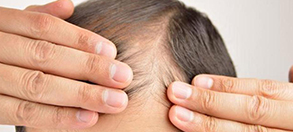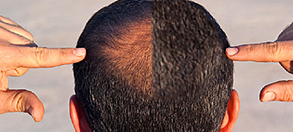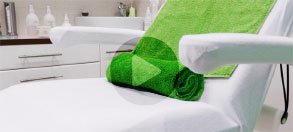What Is Keratin

The Role Of Keratin
Keratin is a vital protein for the production of human skin, hair, and nails. In fact, about 95% of the makeup of hair is simply keratin. By the time that hair is seen on the body, the cells are already dead. Because hair is not seen until the keratin proteins are dead cells, for healthy hair, it is vital to provide the body with adequate nutrition to regulate the growth of keratin proteins while they are still active inside of the body. Vitamins A and D are especially important when it comes to the production of keratin proteins. Consuming proper amounts of these vitamins as well as many others to produce a healthy amount of keratin in the body is a great way to ensure that new hair, nail, and skin growth is healthy. In the event that hair is damaged, keratin supplements and hair treatments are available to restore the keratin content in hair to bring it to a natural, healthy state.
- Keratins (PDF): In this document, detailed information and diagrams are provided to explain the structure of keratin proteins.
- Keratinocytes: This resource provides information about the entire integumentary system and the functions of many cells, including keratinocytes.
- The Role of Keratin Proteins: This document provides information on the role of keratin proteins in relation to the structure and growth of hair.
- The Skin, Hair, and Nails: Here, basic human anatomy, including layers of the skin and functions of keratin, are addressed.
- What is Human Hair? Human hair is much more complex than it may look on the outside. Following this link gives readers further insight into the makeup of human hair.
- Keratin Protein Structure: The structure of keratin proteins is discussed on this website.
- Structure of the Skin: This website features a helpful diagram of the three layers of skin and explains how keratin is useful.
- Alpha-Keratin: Various fibrous proteins, including alpha-keratin and collagen, are defined and explained here.
- Hair and Nails: This website discusses the makeup of both hair and nails, and where keratin is found.
- Proteins: Here, the functions and composition of many proteins found within the body are covered.
- Keratin Structure and Function: Simple definitions of terms related to keratin structure and functions are provided here in addition to photos of keratin proteins.
Keratin In Nature
While human hair is the most commonly known source of keratin proteins, keratin actually is found in many other species. Other mammals produce alpha-keratin, which is responsible for the growth of fur, sheep’s wool, hooves, and horns. Reptiles, birds, amphibians, and fish produce beta-keratin, which is responsible for the growth of scales, beaks, feathers, and skin. The reason for the growth of keratin proteins resulting in these physical characteristics of animals is similar to that of humans; it is for the protection of underlying tissue. Keratin also plays a very important role in the survival of animals against predators as well, as many defense mechanisms, such as claws and shells, are created with keratin proteins.
- Integument: This resource explains the integument and types of hard tissues associated with animal and human skin.
- Structure, Functions, and Mechanical Properties of Keratin (PDF): There are various functions that keratin performs in the human body and in the animal world. This document provides in-depth information about everything that keratin is and does in very understandable terms.
- Birds and Bears and Bed Head: Keratin! Keratin is found in many places aside from human hair, and this link describes the many different places where keratin is found in animals.
- Horns and Antlers: Horns and antlers found on many different types of animals are all made from keratin. The development of horns and antlers is explained on this website.
- Keratin in Teeth : Keratin is found in the teeth of many mammals. This document explains the formation of teeth in many animals.
- Feather Biology: This resource explains the makeup of the feathers found on birds, which are made of keratin.
- Horns and Tusks : Elephants and rhinos have tusks and horns, but elephant tusks are made of ivory while rhino tusks are made of keratin. This document features pictures and explanations on the differences between ivory tusks and keratin horns.
- Keratin in Wool (PDF): This document explains how keratin proteins help sheep to form wool.
- Baleen Whales: The physical characteristics of the baleen whale are covered at this site, including keratin plates found within the mouths of baleen whales.
- Porcupine Quills: This resource informs readers of how keratin plays a part in the development of porcupine quills.
Interesting Facts About Keratin
- Calluses that are found on the body (most commonly on the hands and feet) are caused when too much keratin is produced by the body as a result of frequent friction against the skin.
- Ringworm is an infection caused by fungus known as dermatophytes that eats and is capable of living on keratin.
- As keratin is found in hair, skin, and nails, many cosmetics companies have begun creating beauty products that contain keratin.
- Mammals produce alpha-keratin while other animals, such as reptiles, produce beta-keratin.
- Keratin proteins are responsible for the production of human fingernails, reptile scales, porcupine quills, and even bird feathers.
- Supplements containing keratin are available for those with thinning hair and hair loss.
- Often, the silk fibers that are created by spiders to spin webs and capture other insects are made from keratin proteins.
- Baleen whales have plates of hardened keratin within their mouths, which are known as baleen. The keratin plates help this species of whale with filter-feeding.
- Tortoise and turtle shells, as well as cats’ claws and whiskers, are all made of keratin proteins.
- Keratin is responsible for skin being water-resistant.


